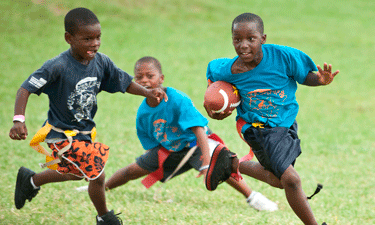 These days, we’re hearing a lot of talk about health and wellness. During the past few years, the Let’s Move campaign and My Plate nutrition guidelines have been in the national spotlight as ways to reduce obesity, heart disease and Type 2 diabetes. However, improving one’s health and wellness starts locally — and often at a park or within a recreation center. As a park and recreation professional, you know the role your agency’s programs and facilities play in improving health in your community. You also know there is not a one-size-fits-all strategy for better health, particularly when it comes to children.
These days, we’re hearing a lot of talk about health and wellness. During the past few years, the Let’s Move campaign and My Plate nutrition guidelines have been in the national spotlight as ways to reduce obesity, heart disease and Type 2 diabetes. However, improving one’s health and wellness starts locally — and often at a park or within a recreation center. As a park and recreation professional, you know the role your agency’s programs and facilities play in improving health in your community. You also know there is not a one-size-fits-all strategy for better health, particularly when it comes to children.
Youth sports are an activity that often disguises its health and wellness impact behind an image of fun and celebration. Many children love playing sports and many enjoy being part of a team. They don’t go into sports thinking about how movement will strengthen muscles and improve flexibility or how deep breaths improve lung capacity. They probably aren’t thinking about the calories they will burn. Kids go into sports because they want to have fun. However, many children are only able to participate in sports because of the opportunities created through local parks and recreation.
Creating access to safe, affordable sports is a significant benefit to youngsters. And, providing opportunities for children with interests in nontraditional sports ensures everyone has the opportunity to engage in healthy physical activity. This is just what ESPN had in mind when it approached NRPA last year with a desire to improve children’s access to sports through local, community-based park and recreation programs. Born from the belief that all children should have the opportunity to participate in sports, ESPN Access to Sports grants fund programs and projects to support youth sports. In spring 2015, grants of $15,000 each were awarded to Los Angeles, California; Hartford, Connecticut; Coral Gables, Florida; New York, New York; Mecklenburg County, North Carolina; Chicago, Illinois; and Austin, Texas.
The grants are helping to expand girls softball and basketball programs, develop Ultimate Frisbee, start up street hockey and make infrastructure improvements to park spaces supporting youth sports. For example, Mecklenburg County is using its grant to renovate three youth baseball/softball fields in a low-
income neighborhood. The Chicago Park District recognized girls sports as a growing need and is directing its grant to a girls basketball program. And, Coral Gables is repairing the tennis court in Phillips Park, allowing youth programming to be expanded within this low-income community.
Just as hiding a bit of spinach in lasagna is an easy way to increase children’s intake of healthy greens, encouraging children to participate in youth sports is a great way to boost healthy activity. However, many private leagues price families out of sports through registration and equipment fees or travel requirements. Park and recreation-based sports not only provide a lower-cost opportunity for children to play sports, but they also offer avenues for children to participate in nontraditional sports, such as skateboarding, parkour, dance and BMX.
Youth sports have seen a steady decline in participation in recent years. The 2014 joint report by espnW and The Aspen Institute’s Project Play provides a look at the barriers and perceptions of youth sports today and the future challenges associated with a decline in youth fitness — from lack of military preparedness to shortened lifespans.
Grants, such as ESPN Access to Sports, to increase children’s participation in sports are helping park and recreation agencies expand their reach and impact. These grants allow agencies to target community needs and desires that have been identified but lack funding. However, as a park and recreation professional, you should not wait for a grant to do what you know needs to be done. Ensure your community outreach — fliers, emails, newsletters, etc. — actually reach the community. Make sure your community knows that your agency is more than ball fields and butterflies. With the expertise of your cadre of staff, partners and instructors, your agency is, quite possibly, the greatest resource and opportunity your residents have to improve their health and wellness. Access to sports is access to health, but access to parks — from economical to physical to cultural — is the critical first step.
Jimmy O’Connor is NRPA’s Director of Grants and Partnerships.

